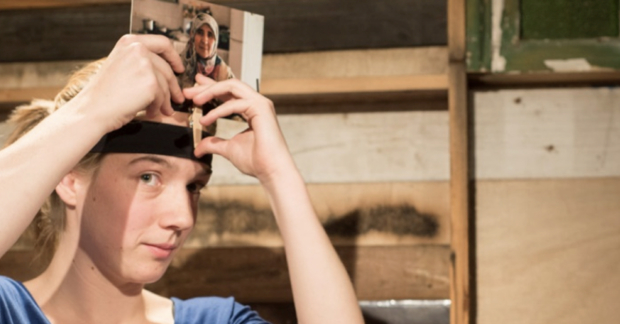We are led to a wooden cabin at the rear of Summerhall, a wee building put together lovingly using a quirky assortment of new pine and found wood, like a little fairy-tale house in the woods. We are grateful to get out of the torrential rain. Somewhere to shelter; a temporary home.
Yinka has entered with us, as if it were her home, and she was bringing us in. Which it is, and she is. We are given tea in big metal mugs, and little biscuits shaped like houses. She tells us that her mother thinks that the biscuits don’t quite work, don’t really look like houses, but I think they do. Anyway, she has baked them and they are sweet and tasty. The rain hammers down. How good it is to have shelter, to have four walls and a roof to protect you, and some hot tea. She takes off her raincoat and sits down behind a table that is occupied just by a box of filing cards/photos and an old-school Sony Walkman cassette player and tapes. And the stories begin…
One Hundred Homes is, as you’d expect, a show about home and homes. A hundred people were visited and interviewed about their home, or lack of a home; their attitude to what ‘home’ means to them, to what makes a home.
Her interviewees include people who live in houses, people who live in flats, people who live on farms, people who live in vans, and people who live on houseboats. There are people who live in grand houses, people who live in squats, and people who live on the streets. Some people have lived in the same house all their lives; some people move constantly through choice; and some have been forced to move, to flee war zones and seek refuge elsewhere. She interviews her own family, and she interviews old school friends. She interviews total strangers and old friends, in her home town of Ghent and in Amsterdam.
The performer’s mode is ‘storyteller’ rather than ‘verbatim’, although she does incorporate the actual words of her interviewees as and when it fits the dramaturgy of the piece. The stories are told in many and various ways – all engaging and inventive. Some are straightforward, some are gently deconstructed and rearranged. Sometimes Yinka recites lists – for example, of names (she says all 100, with hardly a pause for breath). She gives us lists of the types of food and drink she has been offered – tea here, coffee there. Beer here, Coca Cola there. Candies, cakes, even full-blown dinners. These lists are like litanies; a recurring motif.
She turns her attention to the filing cards, and as she takes out each card, she places the photo with it onto the headband she wears – holding the image in place with a peg. It is lovely to see her taking on a token of each person’s identity in this way, as she reads their words, and tells us more about the encounter. The photos show us a couple in love, living together in harmony; a woman who has separated from her partner; a woman who has migrated from Turkey with her whole family; a young man (her own brother!) who lives with his parents but keeps all his belongings in a van; a middle-aged man who is a veteran squatter. All human life is here – men, women and children who started life in very many different places and have somehow all gravitated to the same geographical locations.
Not everyone has a photo. On one occasion, her interviewees plied her so generously with red wine over dinner that she was incapable of using her camera. On another occasion, she interviewed a heavily pregnant woman she met at a soup kitchen in a railway station. The woman went into labour. Yinka broke her self-imposed rules and followed up with a hospital visit to see mother and new born, and the woman’s two other children, safe and warm in a hospital room. She wears the baby’s hospital ID card on her headband. Two days later, the family had to leave. She has no idea where they went.
The joy in the piece is in witnessing the amazing range of human stories and responses encountered and retold. Some people live somewhere for decades and never feel at home. Others, like the couple from Iraq who have fled war, say that home is where their partner is; home is the people, not the place.
I enjoy the fact that the project is more than a theatre show – it is an ongoing art project, Yinka continuing to meet and interview people in every place she travels to. So we can expect Edinburgh to feature in a future incarnation of the work. I like the fact that we got one song, sung by an interviewee, played on the Walkman, but it would have been nice to hear a few more voices.
One Hundred Homes is a beautifully constructed piece of theatre from a young Belgian artist who has the ability to communicate directly with the audience, making everyone feel at home in her presence. Nice biscuits, too.
One Hundred Homes is presented at Summerhall as art of the Big in Belgium programme.

